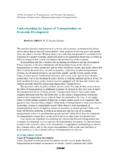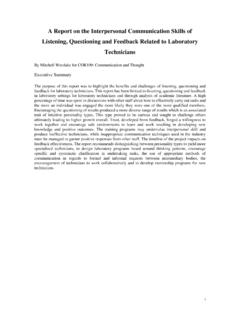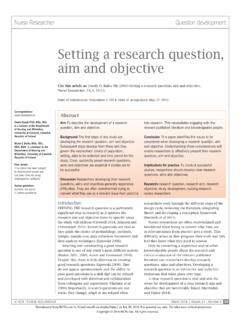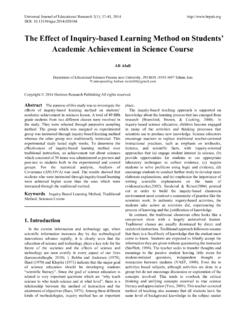Transcription of USING TE TAXONOMY - ec.europa.eu
1 EU TECHNICAL EXPERT GROUP ON. SUSTAINABLE FINANCE. FINANCING A SUSTAINABLE. EUROPEAN ECONOMY. USING THE. TAXONOMY . Supplementary Report 2019. by the Technical Expert Group on Sustainable Finance -1- Table of contents 1. What is the TAXONOMY ? 3. 2. Benefits of the TAXONOMY 7. 3. USING the TAXONOMY 8. 4. What makes a substantial contribution to climate change mitigation? 14. 5. What makes a substantial contribution to climate change adaptation? 16. 6. How to avoid significant harm to other environmental objectives 18. 7. Anatomy of a TAXONOMY activity construction of new buildings 20. 8. How TAXONOMY activities link up 21. 9. What's in the TAXONOMY ? 22. -2- 1. What is the TAXONOMY ? A TAXONOMY is a classification tool to help investors and companies make informed investment decisions on environmentally friendly economic activities. It can help to grow the clean economy of the future and substantially improve the environmental performance of industries we have today.
2 WHAT IS THE EU TAXONOMY ? The EU TAXONOMY is a list of economic activities with performance criteria for their contribution to six environmental objectives. Taxonomies are used in the investment industry and are demonstrated to help drive capital towards sustainability objectives. To be included in the proposed EU TAXONOMY , an economic activity must contribute substantially to at least one environmental objective and do no significant harm to the other five, as well as meet minimum social Technical screening criteria set requirements for determining Substantial Contribution and Doing No Significant Harm (DNSH). The six TAXONOMY environmental objectives: I. climate change mitigation;. II. climate change adaptation;. III. sustainable use and protection of water and marine resources;. IV. transition to a circular economy, waste prevention and recycling.
3 V. pollution prevention and control;. VI. protection of healthy ecosystems. The TAXONOMY will be developed gradually. The Technical Expert Group (TEG) report covers activities that make a substantial contribution to climate change mitigation and adaptation. More activities will be added in the future, including activities that contribute significantly to other environmental objectives. HOW WILL IT BE USED? Under the proposed TAXONOMY regulation, institutional investors and asset managers marketing investment products as environmentally sustainable would need to explain whether, and how, they have used the TAXONOMY criteria. Investors could state that they are seeking to invest in TAXONOMY -eligible activities or disclose their own preferred approach to determine that their investment is environmentally sustainable. 1 Minimum social safeguards would apply to all TAXONOMY eligible investments.
4 For further details see the proposed TAXONOMY regulation eu/info/law/better-regulation/initiative s/ares-2017-5524115_en#pe-2018-3333. -3- HOW WAS IT DEVELOPED? Leading thinkers in the High-Level Expert Group on Sustainable Finance recommended a TAXONOMY , as a key part of deep reforms to make finance more sustainable;. The European Commission responded with a comprehensive plan of 10 actions to reform the financial system with 27 individual initiatives, (The Action Plan), of which an EU-wide TAXONOMY was of the key legal proposals;. A group of experts from finance, academia, civil society and industry (TEG) were appointed to identify initial economic activities and the level of environmental performance they must achieve;. These experts were supported by almost 200 selected experts who provided input to create a proposed list of TAXONOMY activities.
5 WHAT IS INCLUDED? The TEG assessed known climate change mitigation opportunities and tested possible climate change adaptation activities for inclusion in the EU TAXONOMY . Many economic activities are yet to be assessed by the TEG but can be assessed by the future Platform on Sustainable Finance. Some activities were not included in the TAXONOMY if they could not make a substantial contribution or did not meet DNSH criteria. For a full description of the TAXONOMY methodology, proposed economic activities and criteria, see the TAXONOMY Technical Report. -4- THE TAXONOMY IS: IS IS NOT . A list of economic activities and relevant A rating of good or bad companies criteria Flexible to adapt to different investment A mandatory list to invest in styles and strategies Based on latest scientific and industry Making a judgement on the financial experience performance of an investment only the environmental performance Dynamic, responding to changes in Inflexible or static technology, science, new activities and data TAXONOMY activities and criteria Economic activities must meet screening criteria to be included in the TAXONOMY .
6 The screening criteria set requirements for: Substantial contribution to at least one environmental objective Doing no significant harm to the other environmental objectives The criteria may include quantitative or qualitative thresholds that investors should expect companies to meet in the performance of the economic activities. Entities must also meet minimum social safeguards in the performance of the activity. -5- The TEG is grateful to the generous and extensive technical support from consultation respondents and additional experts, as well as the in-depth contributions from the sectoral Commission's Directorates-General and from the Joint Research Centre of the European Commission. Names of TEG members can be found via the TAXONOMY Technical report. 35 TEG Members and Observers 23 contributing on TAXONOMY 257 feedback responses 159 additional experts involved on screening criteria.
7 95% from Europe. from academia, research, industry, policy &. A further 202 feedback responses on regulation, law and civil society. TAXONOMY usability. Consultation Addditional respondents by experts organisation type per sector Industry association Agriculture and forestry Company, SME, micro-enterprise, Manufacturing sole trader Electricity, gas, steam and air Other conditioning supply Non-governmental organisation Water, sewerage, waste and Consultancy, law firm remediation Academic institution Transport Think tank Information and Communication Technologies (ICT). Consumer organisation Climate change adaptation Trade union Objectives 3-6 (DNSH) assessment Additional support from TEG. member organisations -6- 2. Benefits of the TAXONOMY WHY HAVE AN EU TAXONOMY ? Meeting Sustainable Development Goals (SDGs), the Paris Agreement commitments and other environmental goals will require substantial investments far beyond what the public sector can muster.
8 Mobilising and re-directing private capital is necessary for meeting EU's climate, environmental and sustainability commitments. At least EUR 175bn of additional investment is needed each year to help Europe respond to the climate mitigation challenge alone. Through financing or investment decisions, and through stewardship, investors can influence the decisions taken by corporations and other issuers of securities. These decisions have a direct impact on whether, and how, policy goals like the SDGs and the Paris Agreement are met. Policy commitments provide important signals to corporations and other private companies, investors, banks and public entities about future economic trends, investment opportunities and risks. But for capital markets to contribute effectively to these overarching policy goals there is an increasing need to develop and strengthen the toolbox.
9 The TAXONOMY is one such powerful tool. The EU TAXONOMY will provide the following benefits to investors: Provide clarity via a common language for investors, issuers, policymakers and regulators. Investors can use it to express their expectations for their investment decisions. Companies and project developers can use it to plan and raise finance, developing the pipeline of sustainable investment opportunities. All can use it to avoid unintended greenwashing. Help translate commitments to the Paris Agreement and the SDG's for investors. The TAXONOMY bridges the gap between international goals and investment practice, clearly signalling the types of activities that are consistent with the low-carbon transition, adaptation and other environmental objectives. Save time and money for investors and issuers. The criteria have been developed by environmental and industry experts and reference the latest EU and international thinking.
10 This allows investors to focus on what they do best, understanding the risk and return of an investment. Support different investment styles and strategies. Investors marketing environmentally sustainable funds can invest in TAXONOMY -eligible activities; engage companies on how they are progressing towards TAXONOMY thresholds; or provide their own explanation for how they will achieve the fund's goals. Investing in TAXONOMY -eligible activities is not mandatory. Put environmental data in context. Investors need to understand which companies are contributing to the low-carbon transition and which are building resilience to climate change, not just carbon footprints. Avoid reputational risks. By screening out economic activities that undermine broader environmental, climate and social objectives, investors can avoid reputational risk and ensure that their strategy is robust.


















